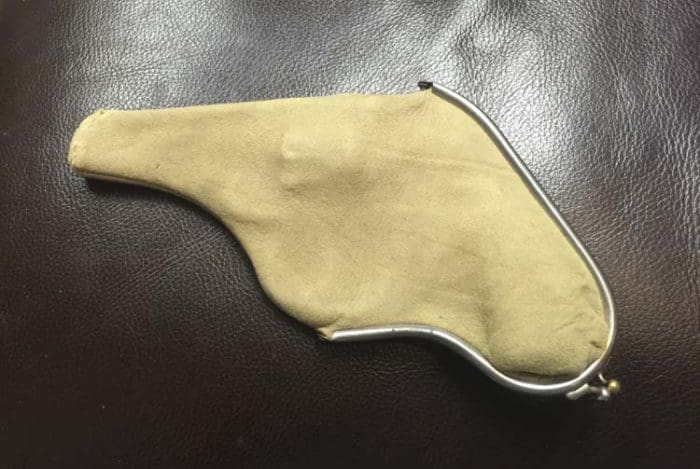Last weekend, I was at a friend’s man cave discussing some business. As usual, the topic of guns came up.
As I was getting ready to leave he said he had something to show me. Out of his safe came the unusual purse-like case you see above made of ostrich skin. Before I opened it up, I knew this was going to be something special.
I admired the fine stitching and craftsmanship with simple soldered buttons that went into making the case. After I opened it and pulled out the diminutive gat inside, I chastised my good friend for not making me wear linen gloves to handle this museum piece.
If you look closely, you can see two of my grimy mitt prints on this museum piece. As best as I can tell by serial number, this beautiful Smith & Wesson Safety Hammerless was made around 1899.
Some info on the pistol from Wikipedia:
The Smith & Wesson .38 Safety Hammerless models were produced from 1887 (1888 for the 32) to just before World War II. They were chambered in either .32 S&W or .38 S&W with a five-shot cylinder. They were most often produced with a 2-inch, 3-inch, or 3.5-inch barrels; but some 6″ barrelled versions are known to exist.[1]
These top-break revolvers were designed for fast reloading and concealed carry as the hammer was internal and would not snag on drawing the revolver from a pocket. They were known as “The New Departure” to reflect the company’s new approach to designing revolvers.[1]
Minor design changes were made to these revolvers over the years, resulting in several different design models, as termed by collectors. The first model was manufactured between 1887-1902. The 38 was based on S&W’s medium frame, while the 32 was based on the smaller sized “1½” frame.[2][3]
The Safety Hammerless is also know as the lemon squeezer. Why? I’m glad you asked.
It’s not that slightly raised hump to the right of the Smith & Wesson medallion ensconced in the stunning mother of pearl grips. That’s a grip safety.
Yup. JMB had a good idea including a grip safety on the venerable 1911, but it was preceded by a few years. In doing some reading on this beauty, I found that it was designed this way so that a child couldn’t accidentally pick it up and shoot it. The grip safety on this beauty is pretty stiff.
Not to sound all Shannon-esque, but apparently children accidentally shooting others was a problem back in the day.
The reason the Safety Hammerless is called the lemon squeezer is because of its general resemblance to the kitchen tool when broken open.
After close inspection, I doubt whether this specimen has ever been fired. Maybe at the factory, but not since. Unfortunately, the cylinder has been turned and you can see a very light score mark.
The bluing and polish work on this 121-year-old firearm is stunning. It’s better than my Colt Python. I didn’t try the trigger. Somehow, it seemed wrong in my mind to dry fire such a beauty.
After a careful wipedown with a soft cloth, this little gem was slipped back into its remarkable case and went back into the safe.
My friend has no plans to shoot the inherited piece. It only comes out of the safe in the man cave during times of quiet contemplation.
[This post was originally published in 2016.]
